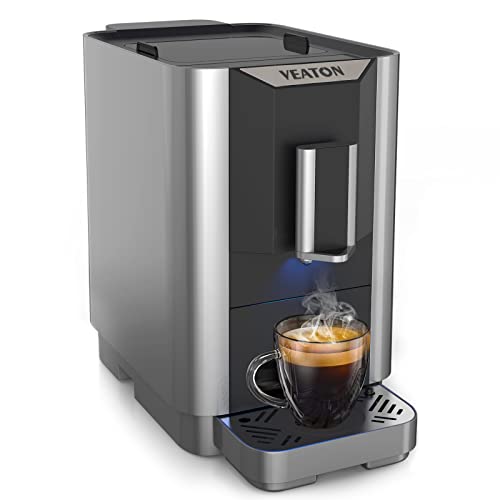How to Make Espresso Machine Coffee
An espresso maker can make a delicious cup of coffee, but it needs some more setup and maintenance than a standard drip coffee maker. You also need to grind and tamp the beans by yourself.
The primary ingredient to make espresso is pressure. Here's how an espresso machine works: a heating vessel is used to heat water to a suitable temperature and then forces it through the grounds before pouring out the spouts.
Temperature
Espresso is made when hot water is forced under pressure through finely ground coffee. The temperature of the water is vital to the quality of the final shot. Low temperatures lead to a absence of flavor compounds. High temperatures can lead to over extraction, which can cause bitter or burnt taste.

The ideal temperature range for espresso is 195 to 205 degrees F. This temperature can be achieved by using an espresso group head that has been designed to ensure the stability of temperature and maintain a constant temperature throughout the brewing cycle. The most popular type of group head is the E61 that offers a combination of temperature stability as well as pre-infusion capabilities and lever control.
It is important to consider the temperature when you adjust your espresso machine for different roasts or brew ratios. This will affect the extraction yield and the crema. The optimal temperature will depend on the specific roast and bean however the general rule is that lighter roasts and higher brew ratios require higher temperatures than darker roasts and lower brew ratios. Additionally, a high quality thermocouple will be essential for maintaining a consistent temperature.
Pressure
During the process of brewing espresso machine coffee is pushed through finely ground coffee grounds that have been put through a tamper. This creates chemical reactions that extract flavors, oils and other soluble components from the beans. The resultant beverage is usually more flavorful and richer than regular coffee.
The ideal espresso machine pressure is nine bars of pressure, that's the same as the atmospheric pressure at sea level. This is due to the fact that it's at this pressure that the coffee bean's soluble components are the easiest to extract.
Some espresso machines boast up to 20 bars of pressure. These machines could achieve these pressure levels, but they might not maintain them throughout the extraction.
To put it into perspective In terms of pressure, one bar equals 32 pounds per square inch, or PSI, of a car tire. It's four times the pressure that a professional cyclist uses to pump up their bicycle tires. The ability to control the espresso machine's pressure, and to make consistent espressos is key for any serious barista at home.
Water
The water that you use in your espresso machine is one of the most crucial elements that make a good cup coffee. The right water allows your beans to extract their maximum potential. However the wrong type of water could cause problems such as clogged pipes, or damage to your expensive machine.
For the best extraction of espresso it is recommended to choose an organic spring with a high mineral content. This water will enhance the flavor of your espresso without the chalky mineral trace that is found in tap water or bottled waters. This is an excellent alternative to distilled water or reverse osmosis, which can be too filtered and cause flavor problems.
But, you shouldn't use water filters that remove too many minerals from your tap water because this can lead to problems with flavor and extraction. One option is to buy a water test kit, which will provide you with your local average water hardness. This can then be used to find the right filtration system to provide the right specifications for the water in your espresso machine.
Beans
Most coffee aficionados tend to get very involved with the entire process of making espresso. They ponder a myriad of variables, including temperature, pressure of water, beans, milk, viscosity, and many other variables. If one of these variables is off even slightly it could make the entire drink taste bad.
The most important element in the matter of espresso is the beans used. Many people believe that certain kinds are suitable for espresso. While some beans are suitable for specific uses but any coffee bean can be used to make espresso. The main difference between espresso beans and regular coffee beans is that espresso beans are roasted more and tipycally over the second crack that gives them an appearance darker and makes them more water-soluble.
The best beans for espresso are usually medium-roasted or dark roasted, giving the shots their characteristic richness and boldness. However, it is also possible to make excellent espresso using light roast beans, especially if the beans are pre-ground (for convenience in the espresso machine).
Milk
Espresso and milk are a traditional combination. The combination of espresso and milk is an old-fashioned. It does not only increase energy levels but it also helps balance the bitterness of espresso. There aren't many culinary combinations better than this one!
If you decide to purchase an espresso machine that also has the ability to create cappuccino or latte make sure to consider how easy it is to use. The best espresso machines come with a jug for hot or cold milk and a steam wand. They also have an espresso portafilter that can be used to make the shot. Some models come with an integrated grinder, tamper and frother.
To remove any condensed water the steam wand needs to be cleaned every day prior to use (or after each espresso cup). espresso coffee machine takes 30 seconds, but it is essential to keep your machine running smoothly. Inability to purge could result in an unpleasant taste or the build-up of bacteria that may alter the flavor and aroma of your beverages. It's simple to perform and should be part of your regular maintenance routine.
